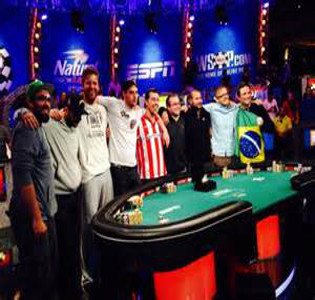
When the World Series of Poker (WSOP) decided the shift the timing of the $10,000 Main Event final table to November in 2008, the move brought with it much skepticism. Players and fans alike criticized the strategy, many believing it harmed the integrity of the tournament, as the four month layoff potentially allowed any skill or fatigue gap that existed amongst players to be narrowed. At best, it would just be anti-climactic. Six years later, where do we stand? Has the November Nine been a success or is it time to ditch the experiment?
The November Nine was instituted for a few reasons. First, Harrah’s (now Caesars) and ESPN wanted to build hype for the final table during the four month hiatus. They could air personal interest pieces about each of the members of the final table and market the event during the lead-up to the big day. And they could structure the broadcasts of the earlier stages of the Main Event so that the narrative would more naturally build to a final table that nobody knew about yet. Previously, the tournament finished in July and when most people watched the final table broadcast months later, they already knew the outcome. Second, players would have the opportunity to land sponsorship deals during the time off and take full advantage of their moment in the sun. Prior to 2008, it was a wild scramble for (mostly) online poker rooms to ink a deal with a November Niner the night before the final table. This was very stressful for the players, took their focus off of the tournament, and didn’t allow them time to conduct proper negotiations or vet their potential sponsorship partners. Third, the final table atmosphere could be improved with the time off, as it gave friends and family the chance to plan a trip to Las Vegas without having to risk their rooting interest not actually making the final table.
I was one of the people who was open to the idea of the November Nine, but then again, I was never a professional poker player. I figured, why not give it a shot? The reasons for the decision were admirable and, having seen the mad dash for sponsorships first hand, I could appreciate that players might find it a relief.
But has it worked? Initially, as far as television ratings go, yes, it definitely worked. The first November Nine in 2008 garnered 46 percent more viewers than the 2007 final table. The broadcast was seen by 2.4 million people, for a Nielsen rating of 1.9. In that regard, it was a resounding success.
This year, Tuesday night final episode drew just 1.15 million viewers, a 0.4 rating, down 6.1 percent from last year. It is clearly not resonating like it used to?
But do we need to change things up again? Maybe. For me, the primary reason to keep the November Nine as it currently exists is because it allows ESPN to put together a much more compelling Main Event broadcast series. During the four month layoff, ESPN can craft and air the Main Event episodes leading up to the final table, allowing fans to see how the tournament developed. Then, the “semi-live” final table episodes flow naturally and nobody has had to try to avoid spoilers for several months. It works well that way.
On the flip side, though, only the most dedicated poker fans watch the entire live final table. Monday’s broadcast went twelve hours and Tuesday’s went for over four more. Poker, frankly, is boring to watch live, even a final table that, as far as final tables go, was quite compelling. Those with a casual interest in poker or those who are curious to give it a shot will turn it off quickly.
And as far as building the hype goes, that just has not happened aside from the broadcast of the episodes leading up to the final table. I watch a lot of ESPN. I work at home and often have ESPN on in the background, even the insufferable First Take. Except on the Tuesdays that a new episode of the WSOP airs, I can’t remember hearing a single mention of the WSOP over the last few years. There is no marketing, no hype at all. The players themselves might get their fifteen minutes of fame, but any interviews or feature pieces on them are almost always limited to poker media and the players’ local newspapers. November Niners don’t get any run outside of the circles they are already in.
So what to do? Honestly, I don’t know. Moving the Main Event final table back to July would remove what to me is the biggest benefit of the November Nine: the entire tournament can be packaged and broadcast with a proper build-up to the live final table. Nobody has to avoid spoilers for four months. If it goes back to July, ESPN will not be able to put together any Main Event episodes before the final table, which would result in a much worse television viewing experience for fans.
Everything else about taking the final table back to its natural spot in July would be either positive or neutral. From where I stand, it doesn’t look like the players benefit all that much in terms of marketing from the time off, though it does make it easier to get friends and family to the final table. Even though I don’t care much about the “integrity” of the tournament, it would be nice to see no break before the final table, or at most just a couple days.
Gun to my head, I say leave it as is. Pre-2008 Main Event viewing was pretty terrible. Even if the ratings haven’t been tremendous and even if some people would prefer an edited version of the final table rather than the live marathon, it is much more enjoyable to watch now than it used to be.


















